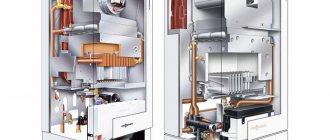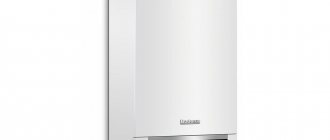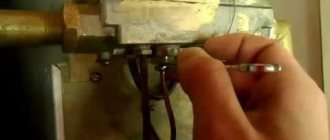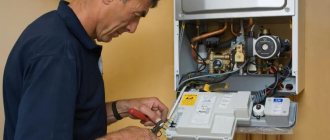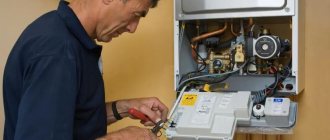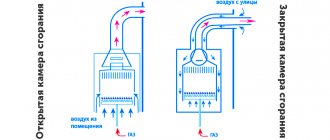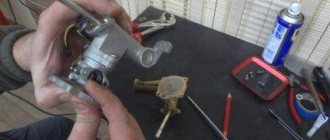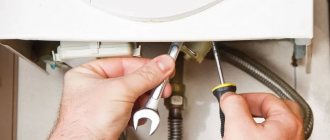Centralized hot water supply (DHW) of residential buildings is becoming a thing of the past; its place is taken by individual water heaters, including natural gas ones. For an apartment or private house that does not have a free chimney, a turbocharged gas water heater is suitable. This new generation water heating device is called “flueless”; it does not require a traditional chimney to remove combustion products. Since flow-through turbo columns are of interest to many users, let us consider the features of these household appliances.
The main advantages of chimneyless gas heaters
Chimneyless geysers are good for many reasons. Firstly, they can be installed without adding a chimney in the traditional sense. Secondly, such equipment has a fairly high efficiency. This is due to forced air injection. Thirdly, the unit has a closed combustion chamber, which eliminates the increase in room temperature, which is especially important when operating the equipment in the summer.
However, chimneyless geysers are chosen not only for the reasons described above. They are also good because they do not burn up the oxygen in the house with their work, since they take air for functioning from the street. In addition, the housing of such devices is almost completely closed, which significantly reduces the risk of combustion products getting inside.
Is it possible to install gas equipment on a motor with a turbine?
In pursuit of the goal of increasing the power of the power plant, automakers often equip passenger and commercial vehicles with turbocharged engines. Owners of such cars also have a natural desire to minimize refueling costs.
An excellent option is to install gas equipment. In this article we will tell you whether it is possible to install an LPG on a turbocharged engine.
Do they install HBO on turbo engines?
Internal combustion engines with a turbocharger can be divided into three types:
- gasoline;
- gas;
- turbodiesel.
We have already written about gas and diesel gas engines. But a gasoline internal combustion engine with a turbocharger is a slightly different story. The power of such motors increases by 10-30% due to the forced injection of compressed air (often cooled) into the engine cylinders.
What is the difference between a (gasoline) turbocharged engine and a naturally aspirated one?
The fuel mixture consists of air (oxidizer) and combustible substance. The correct ratio (stoichiometry) of the gasoline mixture is 14.7:1, where 14.7 is the part of air, and 1 is the part of gasoline. Stoichiometric gas combustible mixture (propane-butane) 15.6 to 1, methane 17.2:1.
A supercharged internal combustion engine receives an increased amount of air; therefore, for the normal operation of such an engine, an accurate and fast supply of the required volume of gas is required.
It is possible to achieve the required fuel mixture ratio in an engine with a turbine only by choosing the right equipment.
- HBO injectors should only be high-speed and productive (such as Hana or AEB).
- The gearbox must have a power reserve (the KME brand has proven itself to be excellent).
Also, in order to avoid the negative impact of gas fuel on the engine, it is necessary to pay special attention to the accuracy of setting up gas equipment.
When making adjustments, it is advisable to use a broadband oxygen sensor.
In addition, it is important to remember that 2nd generation LPG is not suitable for a turbocharged engine. It is recommended to install a gas system version 4 or higher.
Installing HBO on a turbocharged engine
Installing gas equipment on a car with a turbo engine is practically no different from conventional ones. The installation process consists of:
- selection and installation of an HBO cylinder;
- installation of lines (refueling and consumable);
- VZU insert;
- installation of the evaporator reducer in the engine compartment and injectors;
- installation of electrical equipment (wiring, MAP sensor, LPG button).
You can learn more about installing gas equipment from this article.
You just have to remember that due to the increased pressure in the intake manifold, the vacuum tubes must be secured with clamps.
Main disadvantages
Before you purchase the equipment described in the article, you need to familiarize yourself with its main disadvantages, among them the following should be highlighted:
- energy dependence;
- noisiness;
- high cost;
- the need to obtain approval;
- condensation formation inside the outlet pipe.
If you like chimneyless geysers, then before purchasing one of the models you need to become more familiar with the disadvantages of such equipment. For example, many consumers are put off by energy dependence, because the design’s fan is powered by electricity. If it is turned off, the operation of the turbocharged column will be impossible.
You may also be put off by the fact that the equipment fan is quite noisy. Such devices are more expensive than traditional models. On average, the cost of a turbocharged unit is approximately 17,000 rubles. In order to install such a column, approval will be required from the organizations that are responsible for the supply of natural gas. You can’t do it without the permission of the neighbors who live on the floor above. Installing a column requires that the pipe be installed on the façade of the building, which may be prohibited by the architectural control service.
About the negative aspects
An important disadvantage of forced-air instantaneous water heaters is their energy dependence. That is, after a power outage you will be left without hot water. You will need an electric generator or a reliable uninterruptible power supply. The remaining disadvantages of these units are not so critical:
- Buying a turbocharged gas water heater will cost twice as much as an atmospheric one. But if we compare the purchase and installation as a whole, then in the absence of a chimney duct, a coaxial pipe will cost much less than building a brick chimney or laying an insulated sandwich.
- Fans on models from some manufacturers are noticeably noisy.
- A modern forced-air heater is a complex device; its maintenance and cleaning is best left to trained service personnel. Without knowledge and skills, it is not recommended to delve inside the column yourself to find faults.
Gas dispenser display and touch control buttons
Note. In the event of a breakdown, the electronic display of the water heater will display an error code, which can be used to determine the malfunction without resorting to disassembly.
Since we are not comparing a gas water heater with an electric storage water heater, we do not mention obtaining permits from gas services to connect water heating equipment. The procedure for registration and connection to the main line is mandatory for any gas-using installations.
But problems with installing a coaxial pipe on the façade of an apartment building are quite real. Having made a hole without authorization (even in the place required by the standards, observing all the indentations), you may encounter claims from local services, motivated by damage to the facade, drilling of the supporting structure of the house and lack of design documentation.
Advice. First of all, before purchasing such a speaker, obtain the written consent of all neighbors, since troubles usually begin with their complaints about the “stench and suffocation from the pipe.”
You can learn more about water heaters with a closed combustion chamber by watching the video:
Device
The design of devices with forced exhaust follows the design of an instantaneous water heater. Water is heated using the energy of burned gas - natural or liquefied. The liquid is supplied from a water pipe: cold water, heated by a gas burner, enters the water intake point. When the tap is opened, the burner lights up and already heated liquid flows from it. The device has a sealed, closed combustion chamber. A coaxial pipe extends from the chamber and communicates with the street.
The coaxial pipe design has two channels: external and internal. The first serves to supply air to the combustion chamber, the second to remove smoke. What is the advantage of such a technical solution? In a room you have to make only one hole in the wall, and not two - separately for input and output. A prerequisite for the operation of a turbocharged water heater is the presence of a fan that directs exhaust gases into a coaxial pipe.
Control systems
Instantaneous chimneyless water heaters may differ in burner type:
- With automatic power control - automatic burners maintain a given combustion power, so the outlet stream is consistently hot, regardless of the pressure in the pipes.
- With manual adjustment - in this case, the degree of heating can be adjusted with a mechanical switch. But temperature is not a constant value: it is influenced by atmospheric conditions, the temperature of the incoming flow and the pressure in the gas pipeline.
Ignition type
Turbo system speakers may have:
- Electric ignition: the “start” command is given by a sensor that is triggered when the hot water tap opens; power source - batteries or mains. Its advantage is that there is no constantly burning pilot light, which means that gas is not wasted.
- Piezo ignition: a spark appears at the moment of mechanical action on the ignition button. The downside is that the pilot light is constantly on.
- Hydro Turbine Ignition: The built-in generator generates electricity using the energy of the water flow passing through it. Such devices do not require batteries or electricity.
Operating principle of a supercharged heater
If we talk about the principle of operation in general, then all gas instantaneous water heaters work the same way: when the corresponding tap on the mixer is opened, the burner in the unit is ignited by the pressure of the flow and begins to heat the water passing through the heat exchanger. Another thing is how this is implemented in a gas instantaneous water heater with forced air injection.
Functional diagram of a water heater equipped with a turbine
Unlike other types of water heating devices, a gas water heater with a closed combustion chamber operates according to the following algorithm:
- In standby mode, the household appliance is connected to the electrical network. Nothing burns in the chamber because there is no igniter there.
- When the user opens a hot water tap, the flow sensor and the membrane of the water unit are activated. The latter mechanically opens the gas valve and fuel flows to the gas burner device.
- At the command of the controller, a spark discharge occurs on the electrodes located near the burner, igniting the gas. The flame sensor detects the appearance of fire, informs the control unit about this, after which sparking stops. At the same time, the fan is turned on, pumping air.
- The flame, controlled by the controller, heats the water to the temperature set by the user, which is monitored by a separate sensor. When it is reached, the burner power is reduced by reducing the flame (modulation) or turning off 1-2 burner stages.
- After closing the DHW tap, the gas supply is shut off, the burner goes out and the water heating process is completed.
Modulating (left) and stepped burner (photo on the right)
Thanks to a more advanced design, the efficiency of turbocharged columns is higher than that of conventional atmospheric ones (88-90% versus 84%). Efficiency is achieved in the following ways:
- precise dosing of the amount of natural gas and air required for combustion;
- Maintaining the set temperature helps save fuel, since gas is not consumed for excessive heating;
- preheating the air flow in a coaxial chimney.
The last feature is the most effective, since it makes it possible to recover some of the heat carried away with the flue gases. Cold air from the street, passing through a coaxial pipe next to the combustion products, takes away their thermal energy through the steel wall.
Details about the design of coaxial chimneys are shown in the video:
Closed chimneyless dispensers are equipped with several safety levels that are triggered for the following reasons:
- disappearance of draft in the chimney due to the fan turning off after a power outage;
- spontaneous extinguishing of the burner (flame control);
- too low or high gas inlet pressure (automatic gas valve);
- the pressure in the water supply exceeds 10 Bar (water safety valve);
- overheating of the heat exchanger, which can cause a pressure surge and depressurization of connections;
- very low water consumption;
- controller failure.
Note. When the device is turned off by a signal from the heat exchanger overheating sensor, some models provide rapid cooling with a fan that continues to operate after the burner goes out.
Any of the above reasons entails the operation of the gas valve and the cutting off of the fuel supply. Moreover, after a power outage, burner extinguishment and pressure surge in the gas pipe, the valve operates independently, without controller intervention.
To appreciate all the delights of using turbocharged gas water heaters and find out their weaknesses, we suggest that you familiarize yourself with their advantages and disadvantages.
What to consider when choosing a turbo dispenser
When buying a turbocharged water heater, pay attention to the following parameters:
- Thermal power - take the middle option. Don’t chase powerful modifications: they cost much more and don’t fully utilize your resource.
- Performance - this parameter indicates the volume of liquid heated to a certain temperature per unit time. For comfortable use, 10-11 l/min is enough.
- Each model has its own limitation on the pressure in the water pipes - if it reaches a value below a certain limit, the device simply will not turn on.
- Fuel used - there are devices that can operate on two types of gas: natural and liquefied.
- Type of chimney - for example, the Neva column may have a horizontal or vertical chimney outlet.
- Type of ignition - for example, for Oasis speakers, ignition can be electronic or from a piezoelectric element.
How to determine the required parameters
User comfort and resource savings depend on the correct choice of technical characteristics of gas equipment. The buyer can independently determine the required parameters:
- Power. As it increases, the volume of hot flow increases. How can I find out the approximate power level needed? Divide by 2 the value given in the device passport. The resulting result is the flow rate of liquid heated to 30°C per minute. If the value is 20 kW, the device will be able to heat approximately 10 l/min. Knowing the needs of the family, each user will be able to decide whether such opportunities suit him.
- Performance. We are talking about the volume of heated liquid produced by the heater per unit of time. If it is indicated: 12 l/min up to 25°C, then the temperature of the source flow should be added to this value. So, if the cold water temperature is 10°C, then in a minute the device will heat it to 35°C (25 + 10) at a flow rate of 12 l/min.
Important! It is believed that a capacity of 5.5 l/min is sufficient for one water intake point - washbasin, shower or sink.
Installation
Self-installation of gas water heaters is excluded - this should be done by specialists from the relevant services. But you can connect to the water supply yourself. You will need couplings to ensure the tightness of the connections, and a tee - it is necessary to provide hot and cold water. The user can also install a coaxial chimney himself.
Power and Productivity
Correctly selected power affects the operating performance of the device. It is the main parameter of the geyser , which is primarily taken into account when selecting a water heater. A high power level provides a much larger volume of water heated in instantaneous heating mode.
The instructions for the device must indicate its productivity , in other words, the volume of hot water that a flow-type water heater creates in one minute of operation, taking into account the increase in water temperature.
For example, at a temperature of 25 degrees mentioned in the instructions, the buyer can get 14 liters of hot water in one minute. If at the entrance to the gas-type
If the water temperature is 8 degrees, then thanks to the operation of the device it rises by another 25 degrees and at the exit it will be warmed to 33 degrees.
Modern flow-through boilers, which operate without the use of a conventional chimney, have 3 types of ignition systems - hydroturbine ignition, piezo ignition and electric ignition. They make the column easy to use and safe.
Hydroturbine ignition is performed from a hydrodynamic generator. Many current devices have installed mini-hydroelectric power stations, the generator of which is mounted in the wire of the water heater pipes. The incoming water flows through the turbine, rotating its blades, and the generator begins to generate the necessary electricity for the ignition wick. Such water heaters do not need to install additional energy sources needed for ignition.
Piezo ignition has a special element that generates electrical potential from the action of mechanics, which causes a spark to appear, with the help of which the burner is ignited. Such ignition has one drawback - the ignition wick must be in a burning state in advance so that when the water is turned on, the main burner will light.
Electric ignition requires connecting the speaker to an electrical outlet or installing power components, such as batteries or rechargeable batteries. When the tap is opened, the water pressure meter is triggered, which gives the command to ignite the ignition wick using a spark gas discharge device.
Recommendations when choosing
It is impossible to give any definite advice regarding the place of purchase of a gas appliance. You need to focus on stores known for quality of service, a varied assortment, and the presence of decent models.
Specialized plumbing and heating equipment stores offer a large selection of products, the characteristics of which can be seen in person and the appearance of the column can be assessed. Purchasing through an online store also has its advantages - the ability to exchange and return goods within two weeks without specifying the reason, a huge selection, ordering a rare model, reading reviews from other customers.
The Neva gas water heater with a closed combustion chamber is popular. This equipment is characterized by flow-through heating of water, the use of liquefied gas, and the ability to connect to bottled gas. Based on operating practice, it is known that using this device you can obtain 6 liters of hot water per minute. The flow column is equipped with sensors and timers that are responsible for the high-quality functioning of the device. Has a power of 9 kW.
When purchasing a gas water heater, first of all, you should make sure that there is a decent security system for comfortable use of the equipment. It must be equipped with sensors that monitor flame, overheating and backdraft of the chimney. You can choose any ignition option based on your preferences and wishes.
Reviews from real users
There is a good tradition: before choosing a turbocharged speaker, it doesn’t hurt to read the user reviews left on thematic forms. We have made a selection of statements from real people about water heaters from different manufacturers:
- Nikolay, Vladimir, Russian Federation. Six months ago I installed an Ariston MARCO POLO GI7S 11L FFI turbo dispenser. The general conclusion is that the device is worthy and has never let you down. Definitely an A for appearance. But there is one strange thing: heating a given amount of water. I don’t understand this function - either the heating should turn off when the bath is full, or it should turn it off by a signal. I was a little mistaken about the power, in my case I had to take Ariston GI7S 16L, otherwise 11 liters per minute is sometimes not enough.
- Sergey, Moscow, Russian Federation. I made a mistake by buying a Bosch WTD15 AME speaker with a turbine. I didn’t like it already during the installation and connection process. Some of the pipes are flimsy, it’s scary to tighten the nuts. The first time I opened the water, the connection leaked, I had to unscrew it and change the rubber ring. I don’t know how to use it yet, I haven’t turned it on yet.
- Alexey, Dnepr, Ukraine. We haven’t had hot water in our city for a long time, most people installed boilers, but I solved the boiler. It was forbidden to connect a chimney to the ventilation, so I took a Junkers chimneyless unit (German brand, Portuguese assembly). Although I ran around for all sorts of permits, I’m generally satisfied; I don’t have to wait for the water in the tank to heat up. I live on the top floor, there were no problems with the chimney. The gas workers said that it would be more problematic to remove the pipe on other floors.
- Mikhail, Kursk, Russian Federation. Proton exchanged his ancient speaker for a Roda JSD20-T1, a neighbor installed one and praised it. Everything would be fine, but our pressure jumps in the pipe, as soon as I open two mixers at once, the heater turns off, and then lights up again. The gas workers came twice, checked and said that everything was fine with the device. Now we are trying to get the hang of opening the taps one at a time, but otherwise there are no questions, the water heats up normally.
Colorfully designed water heaters look impressive.
In general, reviews of turbocharged gas water heaters are positive, although there are many small nuances that cause inconvenience. Much less negativity is expressed, and most of these reviews are related to the fact that they did not like the product initially or that the equipment could not be installed and connected independently. The latter is quite natural, because in addition to having plumbing skills, you need to be familiar with electrical engineering and know that many imported household appliances are sensitive to incorrect phase connections.
Apartment owners who have used gas water heaters before sometimes do not like turbocharged water heaters, the reason is that the flame is not visible. This gives rise to some psychological discomfort and groundless prejudice towards such products. Good news: you can find turbochargers with a viewing window on sale, for example, the Chinese water heater Selena SWH 20 SE1.
Roda JSD20-T1
A popular middle column in catalogs from a well-known German manufacturer of household appliances. The average price in Russian online catalogs fluctuates around 11-12 thousand rubles.
Characteristics
| Technical Parameter | Implementation |
| Type of equipment | Flow-through geyser |
| Ignition type | electrician |
| Water consumption | 10 liters |
| Design features of the model | There is no way to connect to a cylinder |
| Control | Mechanical round power selector and LCD temperature indicator |
The overall product rating is 4.5. An excellent model, affordable, reliable, and very easy to operate. There is one significant drawback - it does not work on propane.
Manufacturers
The Neva geyser with a domestic chimney is equipped with safety sensors that are automatically triggered when the draft in the chimney is disrupted.
The Italian Ariston Turbo gas water heater is equipped with a closed turbocharged combustion chamber with forced smoke removal and a coaxial chimney.
Chimneys for geysers "Bosch" from a German manufacturer are coaxial chimneys. Chimneys for geysers "Bosch" are characterized as reliable, safe, durable smoke removal systems.
An enameled chimney is installed using straight sections of pipes and ninety-degree bends. The technical characteristics of enameled chimneys allow their use at operating temperatures up to 300ºС.
The photo shows an enameled chimney.
The advantage of a corrugated chimney is that, if necessary, the length of the chimney can increase from one to three meters. Corrugated chimneys are very mobile and also affordable.
The corrugated chimney is shown in the picture.
Almost all modern geysers (especially if they are from a European manufacturer) are equipped with a closed combustion chamber and a coaxial chimney. The advantage of using a coaxial chimney is that there is no need to provide additional ventilation to the room. Since the coaxial chimney is designed in such a way that it not only performs the function of removing flue gases, but also provides the gas burner located inside the gas water heater with the necessary air (and the air is taken from the street, and not from the room).
The picture shows a view of the coaxial chimney from the outside.
Lemax Turbo-24
Lemax Turbo-24
Also a well-known model from catalogs. The production is a Russian-Chinese joint venture, thanks to which the electronics are quite decent and the price is affordable - from 15 thousand rubles.
Characteristics
| Technical Parameter | Implementation |
| Type of equipment | Flow-through geyser |
| Ignition type | electrician |
| Water consumption | 12 liters |
| Design features of the model | Asymmetrical design, good RCD |
| Control | Sensors and a small screen with indicators and numbers |
Rating - 4. Good performance, adapted to Russian networks, but assembly is not always perfect.
WERT 10LT white
WERT 10LT white
An ultra-budget option for the home, it costs only 8 thousand rubles, which is cheaper than many speakers with an open chamber.
Characteristics
| Technical Parameter | Implementation |
| Type of equipment | Flow-through geyser |
| Ignition type | electrician |
| Water consumption | 10 liters |
| Design features of the model | Front heat dissipation grille |
| Control | LCD indicator, two mechanical round selectors |
Rating - 3. Chinese assembly in the worst sense of the word. The turbine is noisy, breaks down, and periodically produces the wrong water temperature. But it's cheap.
Without chimney
Geysers for liquefied gas, which do not require the installation of a traditional vertical chimney, are equipped with a coaxial type of chimney to remove combustion products, which is led out into the street through a pre-prepared hole in the wall. Read an overview of the types of chimneys for a fireplace.
Geysers that do not require the installation of a chimney are fundamentally different in the process of removing combustion products. Geysers are additionally equipped with a special fan that directs combustion products in the desired direction.
Gas water heaters without a closed chimney are equipped with a sealed combustion chamber.
Vatti MR11-N
Vatti MR11-N
Miniature and very low-power speaker. Prices - from 5 thousand rubles.
Characteristics
| Technical Parameter | Implementation |
| Type of equipment | Flow-through geyser |
| Ignition type | Fully electric |
| Water consumption | 4 liters |
| Design features of the model | There are no electronic devices on the dashboard |
| Control | Fully mechanical |
Rating: 2. Heated washbasin. Any theoretical advantages end with performance: the device can hardly serve one mixer.
What diameter should the chimney be?
The diameter is selected taking into account the performance of the column, that is, based on its power. Almost all heaters used in everyday life require a pipe diameter of 11 or 13 cm. At the same time, for devices with a power of up to 20 kW, providing water to one point, a pipe with a diameter of 110 mm is usually chosen, and for a stand with a power of more than 21 kW, from which water diverted to 2-3 taps, pipes with a diameter of 130 mm are required.
Superflame SF0322
Superflame SF0322
“Quality Chinese”, average in price - about 10 thousand rubles.
Characteristics
| Technical Parameter | Implementation |
| Type of equipment | Flow-through geyser |
| Ignition type | electrician |
| Water consumption | 11 liters |
| Design features of the model | Double protection system against overheating and switching on without water |
| Control | Thermometer, indicators, mechanical buttons |
Rating: 4. Average model.
Semi-turbo gas water heaters Termet
Polish-made equipment is quite widely represented on the market. There is a stable demand for these speakers.
Model Termet Aquacomfort Turbo G19-03
Termet Aqua Comfort turbo G19-03
The turbocharged one is equipped with electric ignition equipment. Thermal power is 19.2 kW, the provided hot feed flow is 11 l/min (temperature 25 degrees). Such a column can operate on natural and liquefied gas.
The average cost is 6-7 thousand rubles.
Which one is better to choose?
When choosing a chimney for a gas water heater, you should proceed from personal preferences, but also focus on the technical characteristics of the gas equipment (the thermal power of the gas water heater, as well as the temperature of the flue gases) and its future location.
A coaxial chimney for a gas water heater is structurally composed of two pipes of different diameters, with a smaller diameter pipe (designed to remove combustion products) located inside a larger diameter pipe (designed to provide additional ventilation).
The enameled chimney for a geyser is made of high quality steel with a thickness of 0.6 mm and is coated with heat-resistant enamel to increase its strength characteristics. Additional insulation of the chimney system is required during winter use. Review of technical characteristics and elements of stainless steel chimneys here: https://mykaminz.ru/dymoxod/vidy/nerzhavejka/obzor-texnicheskixe-xarakteristik-i-elementov-dymoxodov-iz-nerzhaveyushhej-stali.html.
The corrugated chimney for a geyser is made of laminated multilayer aluminum foil, and between the layers of aluminum there is an additional reinforcing frame made of steel wire.
Chimneys for geysers made of stainless steel, as a rule, are double-circuit pipes, and mineral wool is used as an intermediate thermal insulation layer.
In the case of a chimney for a gas water heater through a wall, a special hole is prepared and a passage pipe is installed to isolate the chimney pipe from the wall of the house.
When installing a chimney for a gas water heater in a private house, keep in mind that the vertical section of the pipe, from the smoke outlet of the gas water heater to the horizontal section of the pipe, must be at least half a meter. When installing a chimney system, no more than three turns are allowed, and the radius of curvature must be no less than the cross-section of the pipe. Read an overview of types of chimney dampers.
Turbocharged speakers BOSCH
Equipment of this class belongs to an expensive price category.
Model BOSCH Therm 8000 S WTD 27 AME
The products of this brand are highly reliable and of excellent quality. The column can provide a flow rate of up to 27 l/min (25 degrees), the thermal power is 45 kW.
Such a model will cost the buyer 100-110 thousand rubles.
It is advisable to purchase such a water heater to provide hot water to restaurants and bars. In general, the main scope of application is professional use.
Turbocharged geysers are the optimal choice of equipment for hot water supply in the absence of chimneys.
“Selecting and installing a pump in the heating system - is there a need? Induction water heater (boiler) - design and principle of operation »
Regulatory requirements
According to the table of definitions NPB 252-98, the exhaust pipe for a gas water heater is the connecting pipe for the smoke exhaust pipe of the device and the smoke duct.
Accordingly, it transports gas combustion products and must meet the requirements for chimneys. Failure to comply with them can lead to gas pollution in the room and carbon monoxide poisoning. All requirements for chimneys are set out in the following regulatory documents:
- NPB 252–98;
- Rules for the production of pipe and furnace works VDPO;
- SP 42-101-2003, Appendix G
- SP 60.13330.2012, which is an updated version of SNiP 41-01-2003 (replacing SNiP 2.04.05–91).
The main provisions that directly relate to smoke removal from household gas water heaters boil down to the following points:
- The cross-sectional area of the exhaust pipe is taken to be no less than the cross-section of the outlet pipe of the unit;
- It is necessary to ensure complete tightness of the chimney, its resistance to corrosion and high temperatures up to 200 °C;
- Laying connecting pipes through living rooms is prohibited;
- The vertical section of the exhaust pipe at the outlet of the column must be 500 mm high, in some cases it can be reduced to 250 mm;
- Connecting pipes should be up to 3 m long in new buildings and up to 6 m in existing ones;
- It is allowed to use no more than 3 turns with a bend radius no less than the diameter;
- The exhaust pipe is installed at a distance from the ceiling or wall made of non-combustible materials of at least 5 cm, if they are combustible or difficult to burn, then at least 25 cm. The distance can be reduced to 10 cm by taking protective measures in accordance with SP 42-101-2003;
- If the connecting pipe for a gas water heater passes through an unheated room, then thermal insulation must be used;
- The exhaust pipe must be laid with a slope of 0.01 or more towards the appliance.
Smoke ducts are installed in walls made of non-combustible materials and are insulated, if necessary, to prevent condensation. If there are no suitable walls or the building in use does not have channels for removing combustion products, then install a top-type or root-type chimney.
Each fuel-burning device must have a separate smoke duct or pipe. In some cases, it is allowed to remove exhaust gases from the column and boiler into one chimney with an increase in the cross-section of the pipe. In this case, the combustion products must be introduced into the channel at different levels at a distance of at least 0.75 m or at the same level using a cut with a height of 0.75 m and a thickness of 0.12 m.
The chimney must be strictly vertical and have at the base a removable pipe or pocket 250 mm deep with a door for cleaning soot. If it is necessary to bypass existing obstacles, a deviation of up to 30° from the vertical is allowed, while the cross-sectional area is maintained, and the offset should not exceed 1 m.
The height of the chimney is a key factor in creating good draft. It is this that is decisive in the issue of high-quality removal of combustion products. The height of the chimney must be determined in accordance with the diagram given in SP 42-101-2003 (Appendix D).
If there are taller buildings or trees nearby, then it is necessary to additionally check the height of the wind pressure zone and, if necessary, increase the height of the chimney. In any case, the elevation above the adjacent part of the roof must be at least 50 cm, and with a combined (flat) roof - at least 200 cm.
*After installation is completed, the tightness of the smoke exhaust pipe and the presence of draft must be checked. To avoid the risk of loss of draft as a result of freezing of the tip or its blocking by foreign objects, it is prohibited to use nozzles on chimneys in the form of umbrellas, deflectors, etc.
Models with capacity up to 8 l/min
#1
Bosch WTD 12 AME
Reliable and powerful model from a manufacturer with an impeccable reputation
Expert rating:98/ 100
The modification of the Therm 4000 S series from the Bosch brand is distinguished by its standard dimensions, thanks to which the column can be placed even in a small room.
Despite its relatively modest performance, a water heater designed for one water intake point is quite powerful. Therefore, with it, the water almost instantly heats up to 60 degrees. It is also convenient that the Bosch Bosch WTD 12 AME model operates without interruption even with low inlet water pressure: the unit only needs 0.1 atm to start the heating process.
Gas consumption is also pleasing: this column consumes 2.1 cubic meters. m/h when connected to a common gas pipeline and 1.7 cubic meters. m/h when operating from a cylinder. Fuel saving is also facilitated by electric ignition, which turns on the burner only when the tap is opened.
Specifications:
- power – 20.8 kW;
- productivity – 8 l/min;
- minimum/maximum water pressure – 0.1/12 atm;
- control type – electronic;
- dimensions (WxHxD, mm) – 300x568x170.
Bosch WTD 12 AME can be called the optimal model for homes with low pressure in the water supply. And working on liquefied gas from a cylinder allows you to use the equipment even where gasification has not yet been carried out.
Advantages
- Economical
- Control of temperature fluctuations down to 1 degree
- Excellent power
- Heating water up to 60 degrees
- Trouble-free operation at low water pressure
Flaws
- Price
#2
Oasis B-12W
Compact and inexpensive speaker for very small kitchens
Expert rating:96/ 100
The budget speaker from Oasis has low performance, but fully compensates for it with its dimensions and low weight of 4.2 kg. It is one of the most compact in height and depth, making it suitable for small rooms or even niches. Electric ignition is carried out using batteries, which makes the device operate completely independent of the mains.
A bonus is the operation under conditions of low pressure in the gas pipeline. To start heating the model normally, a pressure of 0.02 MPa is sufficient. At the same time, the column maintains high efficiency - more than 90%. The manufacturer provides the ability to limit the maximum water heating temperature, which allows you to save gas.
Specifications:
- power – 11 kW;
- productivity – 5 l/min;
- minimum/maximum water pressure – 0.2/8 atm;
- control type – mechanical;
- Dimensions (WxHxD, mm) – 290x370x120.
Oasis B-12W is installed vertically with bottom connection. The multi-level security system makes operation as reliable as possible, which is especially important for families with children.
Advantages
- Compact and light weight
- Undemanding to pressure in the gas pipeline
- High efficiency
- Reasonable price
- Availability of display and thermometer
Flaws
- The first malfunctions may appear after a couple of years of operation.
Beretta
The Italian concern Beretta produces several gas water heaters with a closed combustion chamber, of which three models are in high demand.
Idrabagno 13 ESI
Idrabagno 13 ESI [gallery2 link=»file» size=»large» ids=»14422,14423″]
| Net power | 24.5 kW |
| Thermal output | 21.5 kW |
| Performance | 8 liters per minute, when heated to +25 C |
| DHW temperature values | From 25 to 58 degrees C |
| Liquid p parameters | 0.1 to 10 bar |
| Maximum gas pressure | 13.5 mbar |
The modest performance parameters of the Beretta Idrabagno 13 ESI are rated by users as 3 points.
Idrabagno 17
Idrabagno 17 [gallery2 link=”file” size=”large” ids=”14425,14426″]
| Net power | 34 kW |
| Thermal performance | 29.5 kW |
| Performance | 17 liters per minute, when heated to +25 C |
| DHW temperature | From 25 to 65 degrees C |
| Water p parameters | 0.1 to 10 bar |
| Maximum gas pressure | 13.5 mbar |
Idrabagno 17 I
Idrabagno 17 I [gallery2 ids=»14428,14429″]
| Net power | 34 kW |
| Thermal output | 29.5 kW |
| Productivity | 17 liters per minute, when heated to +25 C |
| DHW temperature values | From 25 to 65 degrees C |
| Liquid p parameters | 0.1 to 10 bar |
| Maximum gas pressure | 13.5 mbar |
This equipment is rated extremely positively by its owners – 5 points. The entire range of water-heating household appliances with a closed chamber of the Beretta brand have the following advantages:
• economical consumption of electricity, which is used only after turning on the tap; • liquid temperature can be adjusted using a mixer; • the equipment is reliable and characterized by exceptionally quiet operation; • reasonable price, devices are available to a wide consumer audience; • automatic ignition system; • heat exchanger made of high-quality material, burner – simulated; • ability to work even at low water pressure parameters in the system; • modern control system guaranteeing a high level of safety.
The only drawback is the relatively large dimensions, which is fully compensated by the modern elegant design.
Important! Whatever model you choose, the user must understand that only half of the performance and efficiency of the equipment depends on its quality, the remaining 50% depends on competent professional installation.
Models with a capacity of 10 l/min
#1
Roda JSD20-T1
Practical performance speaker in an ultra-thin design
Expert rating:99/ 100
Among gas water heaters operating without a chimney, the Chinese-made model stands out for its more compact depth, which ensures fairly flexible installation. Roda JSD20-T1 is equipped with a gas control system and makes it possible to limit the water heating temperature.
A useful feature of the model is a reliable frost protection system. As soon as the heat exchanger temperature drops below +5 degrees, the built-in ceramic heating elements automatically begin heating the water in the tubes.
The model is maximally adapted to work in conditions of low gas pressure and is extremely sensitive to the opening of a water tap. In addition to the integral gas control, the water heater is equipped with protection against overheating and exceeding the permissible water pressure.
Specifications:
- power – 20 kW;
- productivity – 10 l/min;
- minimum/maximum water pressure – 0.3/8 atm;
- control type – mechanical;
- dimensions (WxHxD, mm) – 330x515x140.
The modification is extremely protected from pressure or temperature surges, has internal control systems, and is therefore optimal for installation in problem housing with old communal communications.
Advantages
- Adapted to difficult operating conditions
- Easy control and setup
- Ergonomic LED display
- Affordable price for the class
Flaws
- Heat exchanger with a short service life
#2
Bosch WTD 15 AME
High-quality water heater with the ability to operate on liquefied gas
Expert rating:98/ 100
Another model from Bosch in the review, capable of providing hot water to homes not connected to the gas supply network. It features impeccable build quality and reliable operation. In addition to limiting the maximum heating of the carrier, the column has a flame modulation system. The option allows you to regulate the strength of the fire, strictly maintaining the set water temperature.
The heat exchanger itself is made of high-quality copper without unwanted impurities, resistant to burnout. The model is assembled conscientiously and is practically not subject to breakdowns.
Specifications:
- power – 25.4 kW;
- productivity – 10 l/min;
- minimum/maximum water pressure – 0.3/12 atm;
- control type – electronic;
- dimensions (WxHxD, mm) – 300x568x170.
Bosch WTD 15 AME belongs to the Therm 4000 S series. It is characterized by economical consumption of blue fuel and has an impressive design. We can recommend this model to consumers who are willing to overpay for reliability, uninterrupted operation and a decent level of equipment safety.
Advantages
- Multi-level equipment protection
- High power ratings
- Stylish design
- High-quality assembly without backlashes or cracks
- Fast heating of water up to 60 degrees
Flaws
- High price
#3
Superflame SF0420T bal (turbo)
The most suitable model for domestic conditions
Expert rating:96/ 100
The SF0420T bal turbocharged water heater is just the type of gas water heater operating without an exhaust hood, which is ideal for working with unstable water pressure. After all, the Superflame brand itself was registered in Spain; most of the brand’s products are aimed at Europe. But after entering the Russian market, the manufacturer improved the speakers to suit the realities of operating conditions in the CIS countries.
Ariston
The Italian manufacturer supplies to the Russian market only one model of gas water heater with a closed combustion chamber - Next EVO, but in two modifications - SFT 11 NG EXP and SFT 14 NG EXP. This new generation device was developed taking into account the peculiarities of Russian conditions and will be able to provide efficient water supply, even when water consumption changes. It is highly economical, has an improved design and expanded functionality.
SFT 11 NG EXP
SFT 11 NG EXP [gallery2 ids=»14418,14419,14420″]
| Net power | From 8.5 to 19 kW |
| Thermal output | 21.5 kW |
| Performance | 11 liters per minute, when heated to +25 C |
| DHW temperature values | From 25 to 65 degrees C |
| Liquid p parameters | 0.1 to 10 bar |
| Maximum gas pressure | 20 mbar |
The SFT 11 NG EXP rating, according to user and expert reviews, is 5 points.
SFT 14 NG EXP
This modification differs from the basic one in productivity and other characteristics, which allows the consumer to choose the best option for specific operating conditions.
| Net power | From 9.0 to 24 kW |
| Thermal performance | 27.0 kW |
| Performance | 14 liters per minute, when heated to +25 C |
| DHW temperature | From 25 to 65 degrees C |
| Water p parameters | 0.1 to 10 bar |
| Maximum gas pressure | 20 mbar |
Advantages of chimneyless water heaters
As we have already found out above, there is no gas water heater without a chimney, and in the case of turbocharged units it is structurally simplified. This is the main advantage of forced-air water heaters, thanks to which they can be installed in any private house or apartment. It is enough just to lay the chimney horizontally along the shortest path from the apparatus to the outer wall and take it outside by making a hole.
This is what a coaxial chimney looks like when laid through an external wall
For reference. If necessary, a coaxial pipe can also be installed on the roof of a private house by laying it vertically inside a finished shaft or directly through ceilings lined with non-combustible materials. Details about connecting chimney pipes to geysers are presented in this article.
Now we list other advantages of “flueless” gas heaters:
- Increased efficiency and cost-effectiveness compared to traditional household appliances for heating hot water;
- Thanks to the closed chamber, the penetration of harmful gases and unpleasant odors into the premises is excluded;
- To install a water heater, it is enough to organize regular supply and exhaust ventilation, since it is impossible to do without a hood completely. But you don’t have to worry about how to arrange a supply of fresh air for combustion in the room.
- The high degree of automation of the turbocharged column makes it very convenient to use.
- The ability to use not only natural but also liquefied gas as an energy carrier. True, this requires a special hood located in the lower zone of the room (propane is heavier than air and spreads along the floor).
The water heater is closed on all sides, with a pipe for connecting a coaxial pipe coming out from above, and fittings for water and gas from below
. In addition to several sensors responsible for the safety and maintenance of water temperature for domestic hot water needs, the forced-air dispensers are equipped with a heat exchanger antifreeze system. The principle is simple: when the temperature in the room drops below zero, the electric heating element will automatically turn on, heating the heat exchanger and preventing the water from freezing.
The anti-freeze function in a turbocharged column may be useful in case of emergency shutdown of the heating system in winter. It will keep expensive equipment from defrosting until the owners take measures to heat the house. True, it is unknown what will happen to cold water pipelines if they are made of steel or polypropylene.
For reference. Not so long ago, condensing geysers appeared on sale, working even more efficiently than turbocharged ones. An example is the BOSCH WTD 27AME THERM 8000 S with a power of 48 kW and a capacity of 27 l/min, whose efficiency exceeds 90%. But for now they are extremely expensive (the price of the specified copy is 1550 USD), and therefore are practically inaccessible to the average user.
Construction of a condensation column with a cylindrical burner
Installation features
The presence of a coaxial chimney determines some differences in the installation of turbocharged gas boilers and atmospheric ones. In addition, the installation technology is influenced by the type of unit design - floor or wall.
After installing the boiler on the floor or mounting it on the wall, it is connected to the heating circuit main and to the gas pipeline. The next step is connection to the power supply network. In this case, it is necessary to fulfill two conditions - the use of a voltage stabilizer and grounding of the unit housing.
Next, you can begin installing the coaxial chimney. All structural elements must be factory-made and connected to each other without the slightest gap; however, it is not allowed to join pipes inside walls or ceilings.
As a rule, gas boiler manufacturers recommend that installation work be carried out only by qualified specialists. Such devices include, for example, the Vaillant Turbo TEK Pro gas boiler, the instructions for which warn that the unit must be installed by a specialist certified by the manufacturer, otherwise the Vaillant warranty will become invalid.
Important! According to fire safety requirements, the openings through which chimneys are discharged should be sealed with fire-resistant material.
There are several options for laying the exhaust pipe: horizontally, vertically or at an angle. Most often it is mounted horizontally through the wall of the house. When installing a chimney horizontally, it is necessary to ensure that it slopes slightly towards the street to allow the condensate generated during operation of the gas unit to drain out. You can read about what a condensing gas boiler is, as well as its advantages, by following the link.
If it is not possible to lay the chimney horizontally, it is installed vertically and led out through the roof. In this case, care should also be taken to remove condensate during operation of the boiler.
